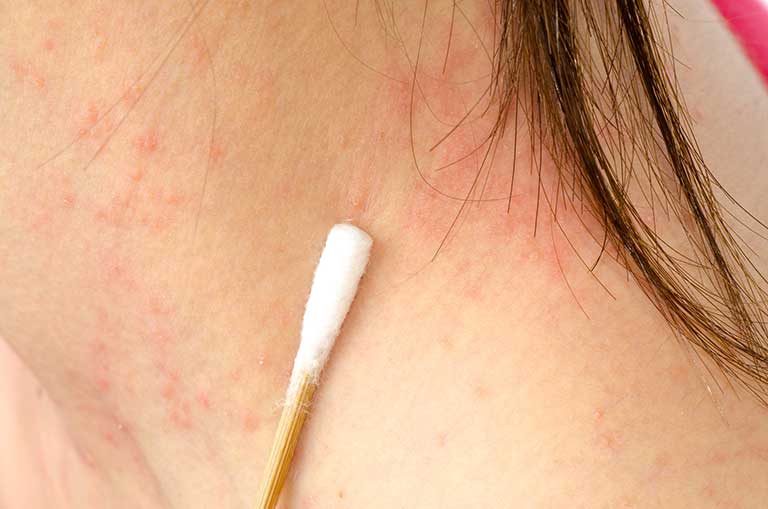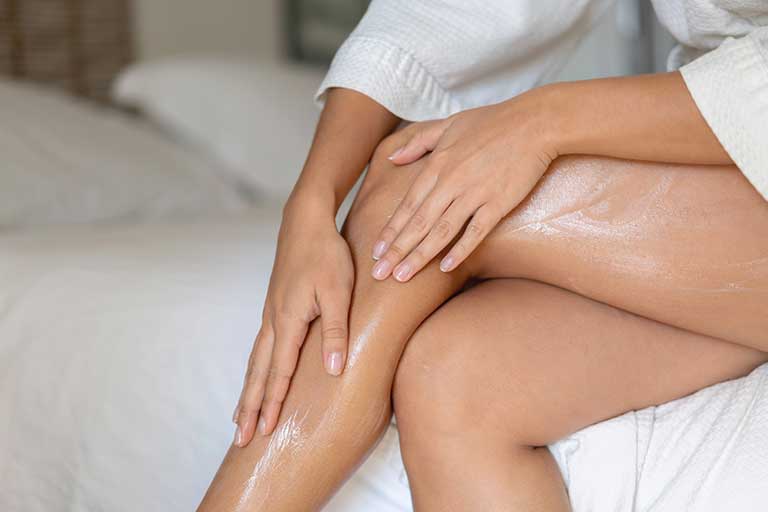All about Atopic dermatitis
Atopic dermatitis (AD), or atopic eczema, is a non-contagious chronic, inflammatory disease of the skin.

Treatment
The treatment of atopic dermatitis (AD) is mainly focused on the daily practice of basic skin care, aside from the use of topical anti-inflammatory agents, phototherapy and systemic immunomodulators. The main objectives of the management of atopic dermatitis (AD) include treatment and prevention of outbreaks, and reparation and maintenance of the skin barrier. The course of the disease is different for each patient with AD, and therefore treatments must be individualized bearing in mind patient factors, such as age or adherence, or disease factors, such as extension, distribution, acute outbreaks or chronic disease.
For the treatment of AD, there are several measures and different agents that can be administered to consider:

- Emollients for dry skin.
- Topical or sistemical anti-inflammatory or immunomodulatory therapy for eczema/inflammation.
- Disinfectants in case of a bacterial infection.
Despite using all of them, due to the complex physiopathology of atopic pruritus it may persist, so symptomatic antipruritic therapies will be necessary.

Non-pharmacological treatments
A. Treatment of xeroderma (dry skin)
General daily skin care for AD includes:
I. Emollients
The use of emollients in the management of atopic dermatitis is pivotal. They should be applied several times a day, and a systematic use has been shown to reduce the need for corticosteroid creams. The main reason for intensive use of an emollient is its ability to increase the hydration of the epidermis, mainly by reducing the evaporation, as it acts as an occlusive layer on the top of the skin. As such, emollients have no direct effect on the course of the eczema. However, the appearance of the skin is enhanced, and itching is reduced.
The choice of emollient depends on the individual patient. It is generally recommended that a thick (with a high fat content) cream or ointment is used for the driest skin, whereas creams and lotions with a higher water content are used only for very mild eczema. Such creams must be applied several times a day because of their rapid absorption into the skin. It is important to recommend an emollient without perfume or other potential allergens as they may provoke secondary allergic sensitization. Those with chronic, dry eczema benefit from tar preparations in the form of creams and occlusive bandages.
II. Bathing and showering practices, including bath additives
Bathing or showering daily, for about 5-10 minutes, may hydrate the skin and remove scales, crusting, irritants and allergens, which may be useful for patients with AD. However, letting water evaporate from the skin will cause a higher loss of transepidermal water, so it is recommended to apply moisturisers shortly after bathing or showering to keep the skin well hydrated.
If any area of the skin is significantly swollen, it is recommended to soak it in running water for 20 minutes, and then immediately apply an anti-inflammatory pharmacological treatment, such as CTs, without drying it with a towel. This technique is called "Soak and Seal," and it may improve the response in cases where only applying a topical antiinflammatory is not appropriate.
It is recommended to limit the use of cleansers without soap containing low or neutral pH, or that are hypoallergenic or unscented.
III. Wet wrap therapy
Wet wrap therapy (WWT) is a method to quickly reduce the severity of AD, and it is usually used, both in ambulatory or hospitalized patients, for significant outbreaks of the disease. In general, the technique consists of applying a topical agent and covering it by a moist first layer of tubular bandages, gauze or a cotton suit, followed by a dry second outer layer. When the condition is generalized, two layers of non-irritant clothes may be applied in a similar way. WWT seems to help with occlusion of the topical agent to increase penetration, reduce water loss and provide a physical barrier against scratchings.
The wrap may be used from several hours to up to 24 hours, depending on the patient's tolerance. In general, it is suggested to use it for several days, although some studies regarding this technique continued it for up to two weeks.
IV. Phototherapy
As most patients affected by AD improve during the sunny summer season, artificial UV radiation is frequently employed in the treatment of AD. Phototherapy can improve and even clear AD; it can decrease bacterial colonization and reduce the strength and/or the amount of topical anti-inflammatory drugs needed, but the beneficial effects vary from person to person.
Pharmacological treatments
A. Topical anti-inflammatory therapy
Effective topical anti-inflammatory therapy depends on three fundamental principles: sufficient strength, sufficient dosage and correct application. Topical treatment should always be applied on hydrated skin, especially when using ointments. The emollient should be applied first when it is a cream, 15 min before the anti-inflammatory topical is applied and when it is an ointment 15 min after.

I. Topical corticoids
The use of anti-inflammatory topical corticoids (CTs) may lead to the improvement or resolution of acute outbreaks in a matter of days. CTs are used in the treatment of AD both in adults and children, and they are the foundation of anti-inflammatory therapy. They act on a variety of immune cells, including T lymphocytes, monocytes, macrophages and dendritic cells, interfering with the processing of antigens and suppressing the release of proinflammatory cytokines. They are usually introduced in the treatment regimen after lesions do not respond to good skin care and regular use of moisturisers as monotherapy.
II. Topical calcineurin inhibitors
Topical calcineurin inhibitors (TCIs) are a second line of treatment for moderate-to-severe AD in patients. They inhibit the calcineurin-dependent T cell activation, blocking the production of proinflammatory cytokines and mediators of the inflammatory reaction of AD.
B. Systemic agents
Systemic immunomodulatory drugs are a common option for the treatment of chronic and/or serious inflammatory diseases. These agents are indicated and recommended for atopic dermatitis (AD) in patients in which optimized topical treatments and/or phototherapy cannot properly control the disease, or when quality of life has been substantially affected.
C. Treatment of bacterial infections
Although it is not recommended to use systemic antibiotics in the treatment of non-infected AD, they may be applied in patients with clinical evidence of bacterial infection.
References
- Eichenfield, L.F., Tom, W.L., Berger, T.G., Krol, A., Paller, A.S., Schwarzenberger, K., et al. Guidelines of care for the management of atopic dermatitis: section 2. Management and treatment of atopic dermatitis with topical therapies. J Am Acad Dermatol. 2014;71(1):116–32.
- Ring, J., Alomar, A., Bieber, T., Deleuran, M., Fink-Wagner, A., Gelmetti, C., Gieler, U., et al. Guidelines for treatment of atopic eczema (atopic dermatitis) Part I. JEADV. 2012;26:1045–1060.
- Ring, J., Alomar, A., Bieber, T., Deleuran, M., Fink-Wagner, A., Gelmetti, C., Gieler, U., et al. Guidelines for treatment of atopic eczema (atopic dermatitis) Part II. JEADV. 2012;26:1176–1193.
